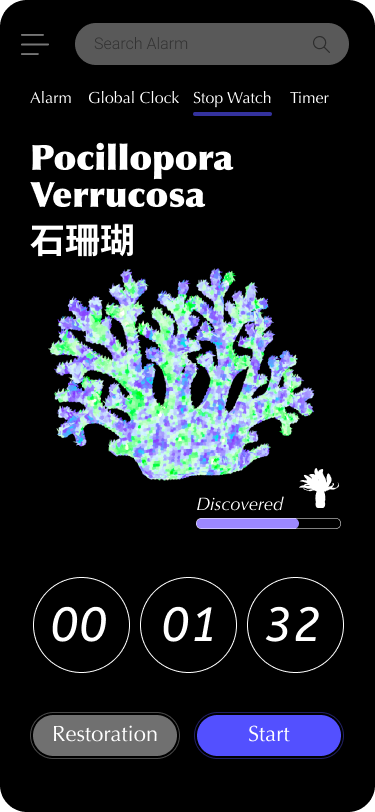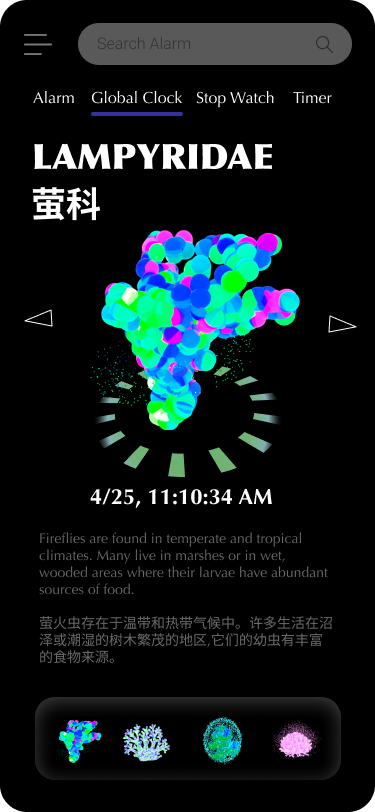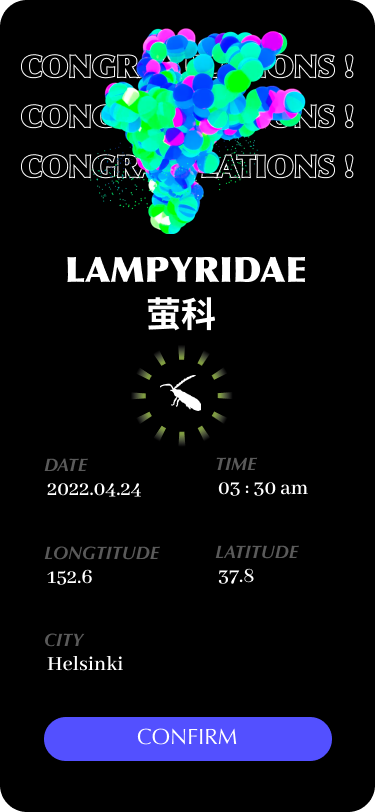Keyi GU 古珂懿 Oliver CAO 曹焰铖
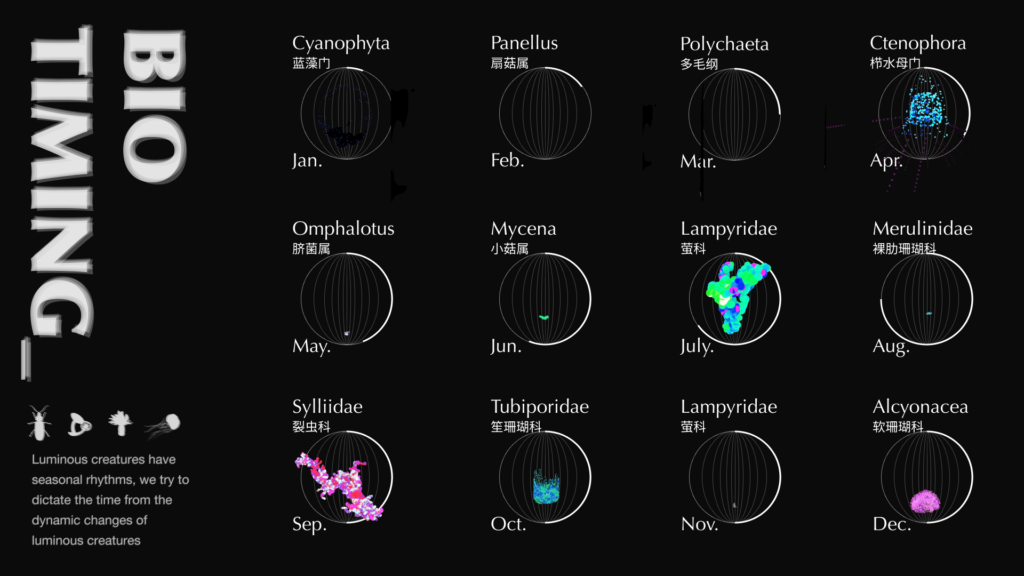
Case Study
Some cases about visualization of nature

Some interested points about nature
Nature is a complex system, each part is inextricably linked, and we know very little about it. Therefore, after simple research, we have produced some points of interest in nature.
- earthquake, which shows the power of geology
- tree rings, which shows the time recording of forest
- flowering, which is the one of the most beautiful part of nature
- poisonous plant, which is a special way for nature to protect itself.
- soil, which feed both nature and human
- Bioluminescence, which is a magical part of China but seldom found by human
Finally we choose Bioluminescence as our research target.
Data Driven Research hypothesis
Why Bioluminescence
Magical Appearance
The phenomenon of bioluminescence is very magical. We rarely encounter it in our lives. It is a very interesting part of nature.

Eager of Knowledge
There are a lot of questions we want to ask, such as : What species are they? Where can we find it ? Why can they glow? Why they should glow? What’s the color of them? What’s its relationship between the bioluminescence and human-beings?
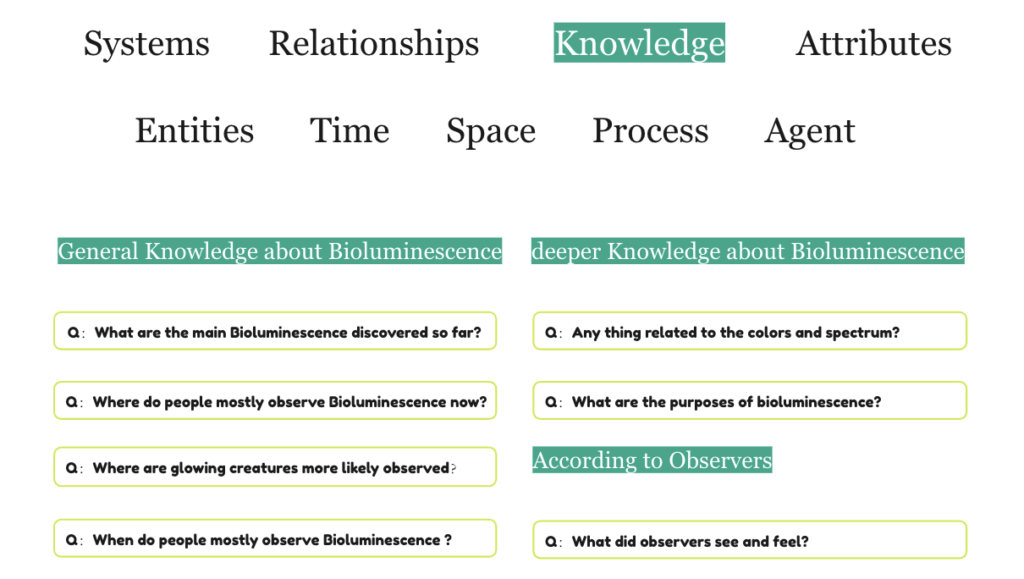
Dataset Obtaining
iNaturalist
iNaturalist is a joint initiative of the California Academy of Sciences and the National Geographic Society. Human can use iNaturalist to share information with other people who are interested in nature. It is also an opportunity for users to validate the photos and information recorded during field trips, and to provide information on species distribution for the IUCN Red List assessments.
There is api for us to obtain data from it. The link: www.inaturalist.org/observations/export?flow_task_id=216239


Other Completing
Some datasets about fungi and poisonous plants.


Visualization work
Visualization of Scientific Classification
Kingdom – WHAT
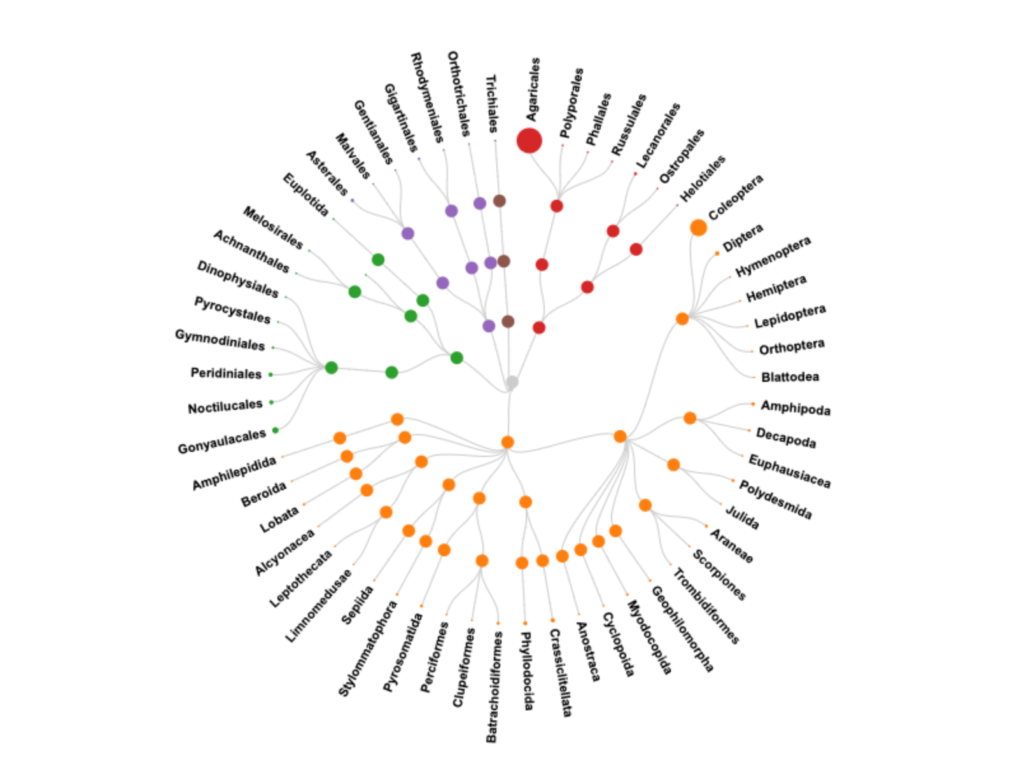
Based on the data by observed by iNaturalist user. The light-emitting organisms discovered now are mainly fungi, animals and chromista. Look down to the lower level such as Order, agaricales and coleoptera are the biggest groups.

In fact, observed organisms in the fungal kingdom account for the largest proportion. But it doesn’t necessary means fungi has the largest group of bioluminescent species. We think the reasons for the result can be :
- There are many deep-sea animals in the animal kingdom that can emit light. According to scientific statistics, these light-emitting animals account for about 80% of all light-emitting creatures. But since they live in the ocean, people do not often see them.
- Observations of Algae glowing need to be made at a specific time, when the glowing algae are gathered together and the angle of incidence of the light is suitable.
- Protozoa are too small to observe.
- Plants that can emit light are relatively rare, which may due to the slow oxidation of phosphorus on the body surface.(Their emission process tends to be bioinorganic)
Phylum, Class, Order ,Family, Genus,- Where
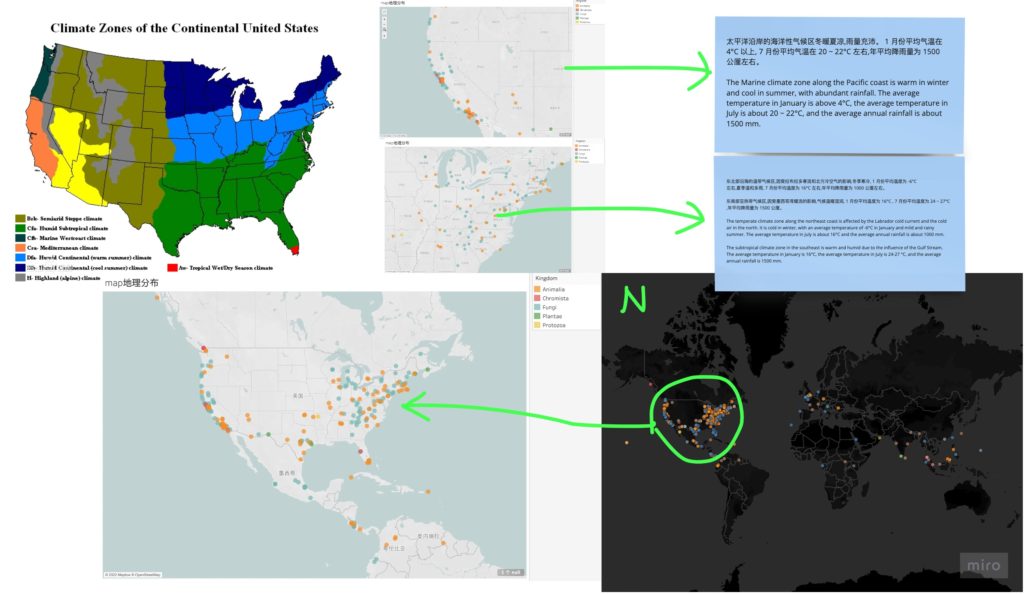

We guessed that the distribution of these luminescent species must be related to climatic conditions, and then analyzed the climatic characteristics of the luminescent organisms gathering zone: it is more common in temperate continental climate and subtropical humid climate zone. Part of the reason, we suspect, is that such climatic conditions are favorable for the vast majority of species. Another one may be related to the material and energy conditions required for bioluminescence reactions.
We tried to analyze the regularity of luminescent biological observation events from the perspective of geographical distribution. Firstly, we visualized the luminescent biodistribution found by all iNaturalist users.
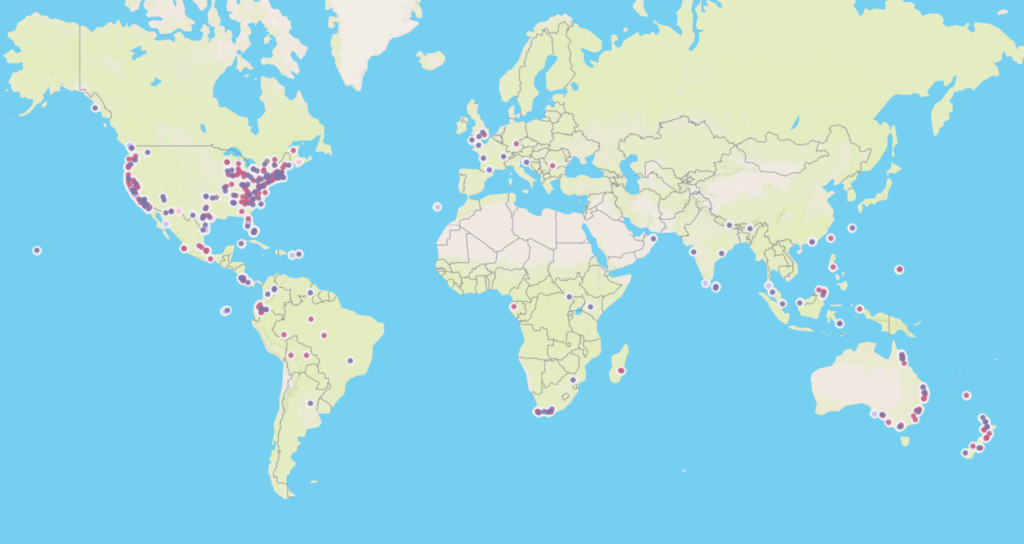


First of all, according to the global overall map, we can find that luminescent organisms are mainly distributed in the United States, New Zealand, and the southeastern coastal areas of Australia. We speculate that the users of iNatualist are mainly distributed in these three areas.
After that, we changed the map into satellite version and found the relationship between the location distribution of luminous organisms and the geographical environment.

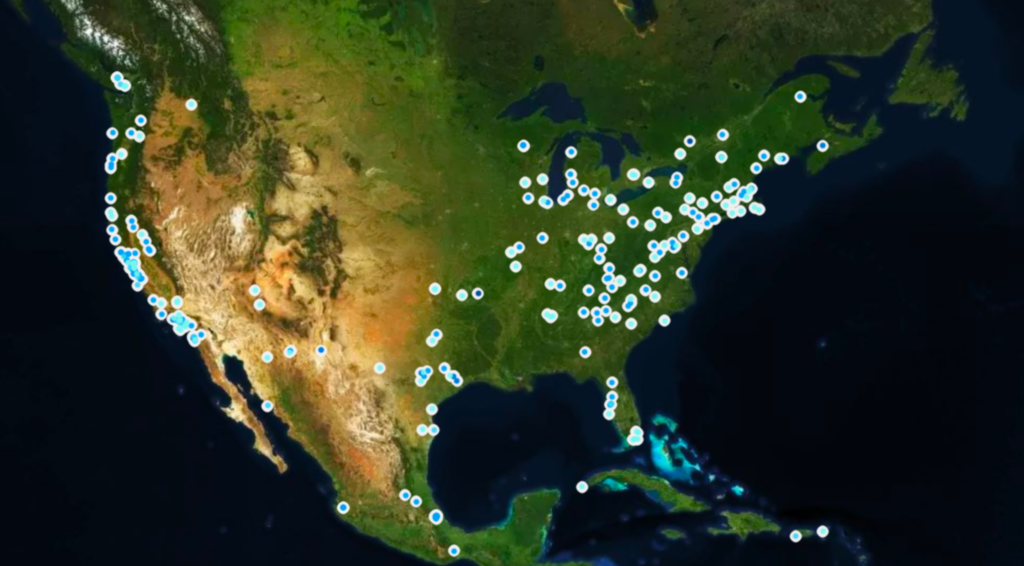



It can be seen that luminescent organisms are mainly distributed in coastal areas or inland densely forested areas. Next we tried to explore how different species of species differ in their distribution. Therefore, we subdivided the latitude down, and selected the Arthropoda and Basidiomycota in the fungi kingdom for subdivision research, because these two species have the largest number and are more representative.


After refining the classification to the phylum level, we found that the distinction between the two species was still not significant enough, and we continued to subdivide vertically downwards. The figure below shows the breakdown for the phylum Arthropoda.
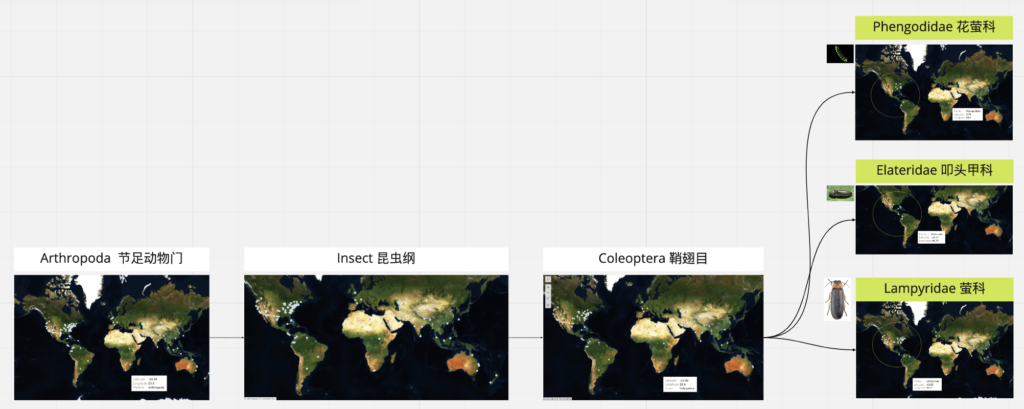

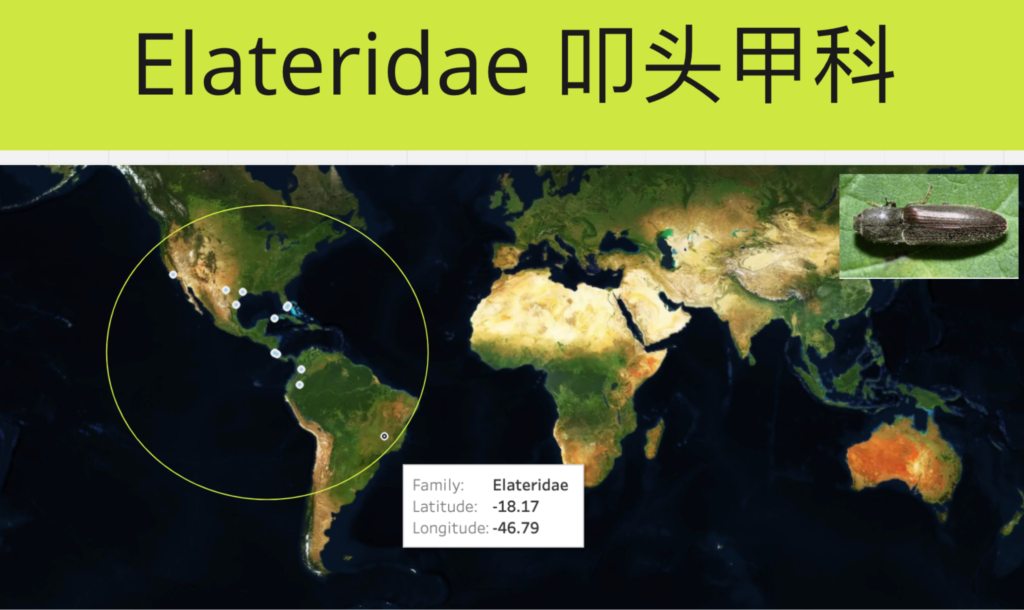

For the phylum Arthropoda, it is not until the family level that we find pre-species differences. There have been some differences between the firefly family, the clasperidae, and the firefly family. For fireflies, we also looked at additional literature showing species adapted to mesophyll tropical forests, secondary plants, swampy areas and open fields where their larvae have abundant food sources. This also explains why the observed fireflies exhibit the above distribution pattern.
Below, we perform a detailed analysis of the Basidiomycota phylum.

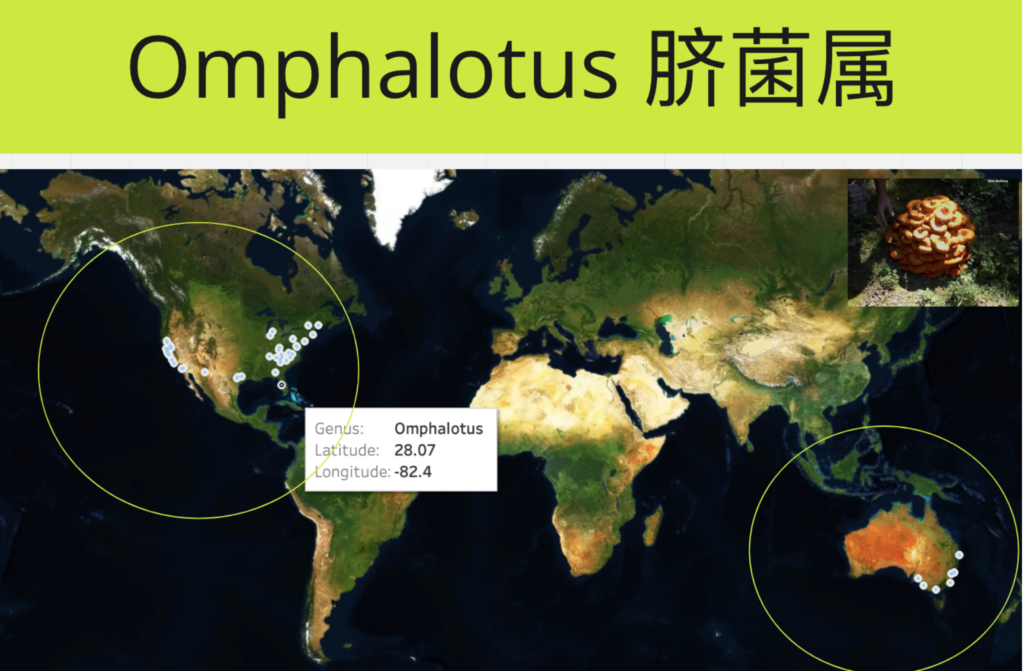
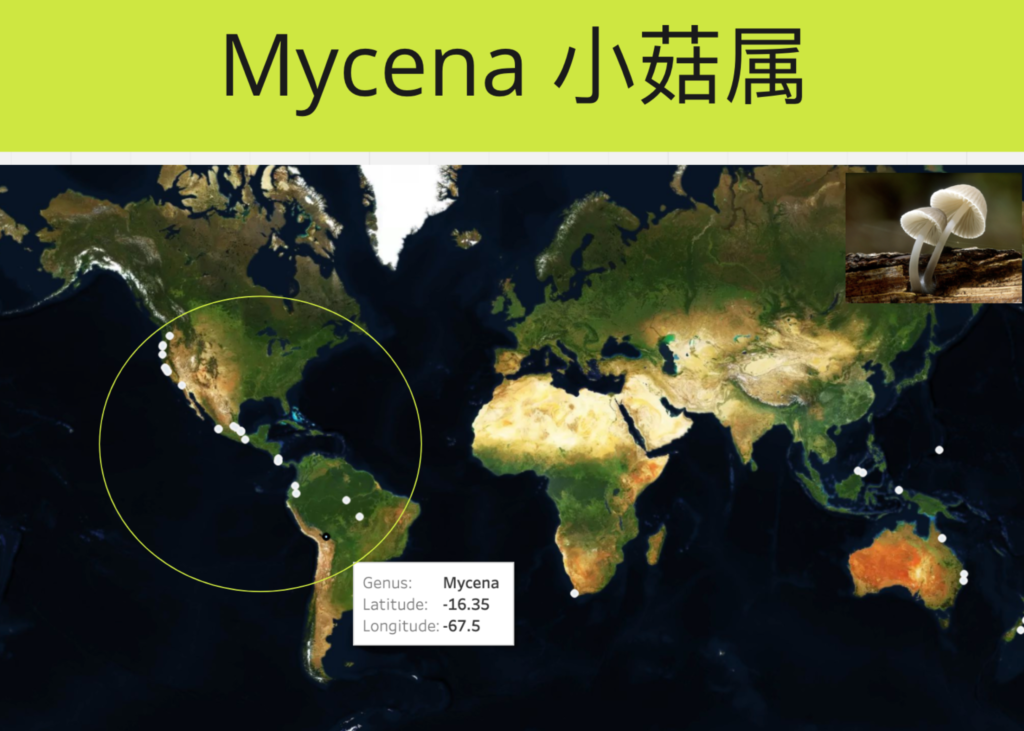

For Basidiomycota, we did not find differences in species distribution until the genus level. The genus Umbilus is mainly found in Australia, while the genus Pleurotus in the Americas is also quite different from the genus Pleurotus. Pleurotus is mainly distributed on the west coast, and Pleurotus is mainly distributed on the east coast. The specific reason should be related to the habitat conditions of these genus, and we will check more literature to confirm.
We next asked the question: Why would this part of the creature need to glow in these regions?
Combined with the literature, the following conjectures are made:
- It is simply the way in which this type of creature attracts a mate for reproduction.
- In forests or swamps, where there is less wind, immobile organisms such as fungi need to attract insects through light to help them spread spores to reproduce.
- The climate is humid, the oxygen is sufficient, and the trees are lush, all of which provide the basic conditions for bioluminescence—the process of luciferase decomposing luciferin requires lignin, reactive oxygen species, suitable temperature and humidity, etc.
Family, Genus, Species – When
Here we mainly analyze the regularity of bioluminescent observation events from the time dimension. Due to the differences in suitable living conditions and life cycles among species, we refined the granularity of species classification to an appropriate category to ensure the similarity of species and the sample size within a credible range. In addition, due to the differences in seasons between the northern and southern hemispheres, we classify them and discuss them.
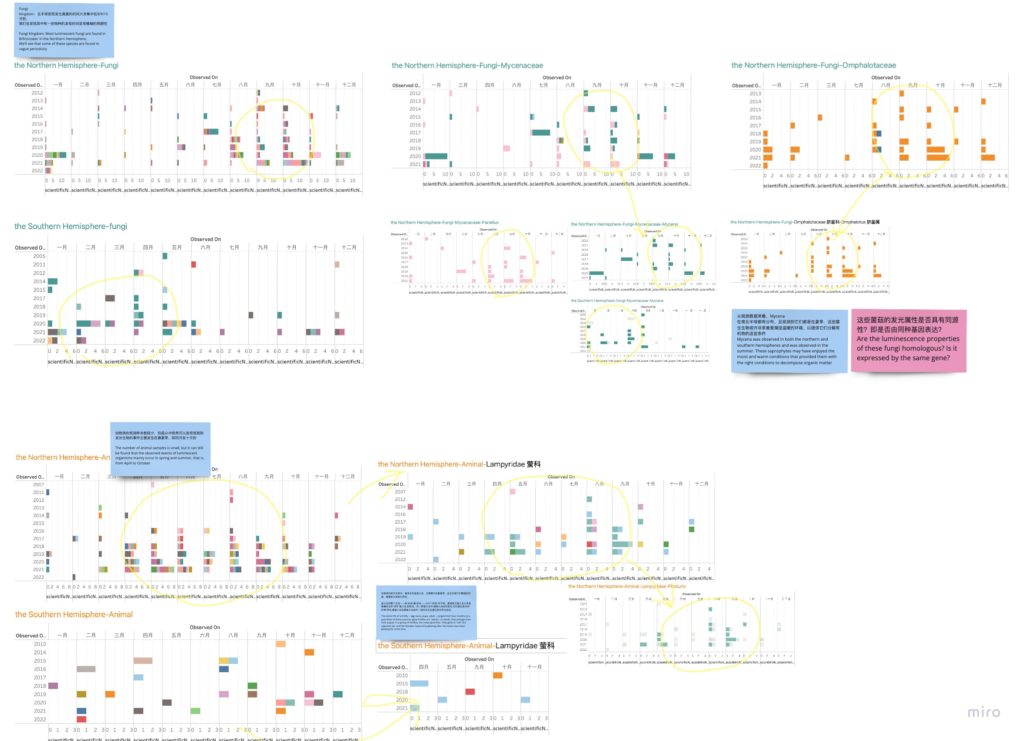
该系列图表按照一年份为单位统计了从2005年起至今人们在南北半球分别观察到发光生物(按照Fungi、Animal两个大类进行区分,再深入细分至family)的事件次数。图表色彩代表species的区分,是为了能够在查看人们所观察到发光物种的次数统计外,还能够观察该时段内观测到的发光生物物种的丰富程度。
This series of charts shows the number of bioluminescent species (classified by Fungi and Animal, and further subdivided into family) observed in the northern and southern hemispheres since 2005.The color of the chart represents the classification of species in order to observe the abundance of bioluminescent species observed during that time period in addition to the number of observed bioluminescent species.
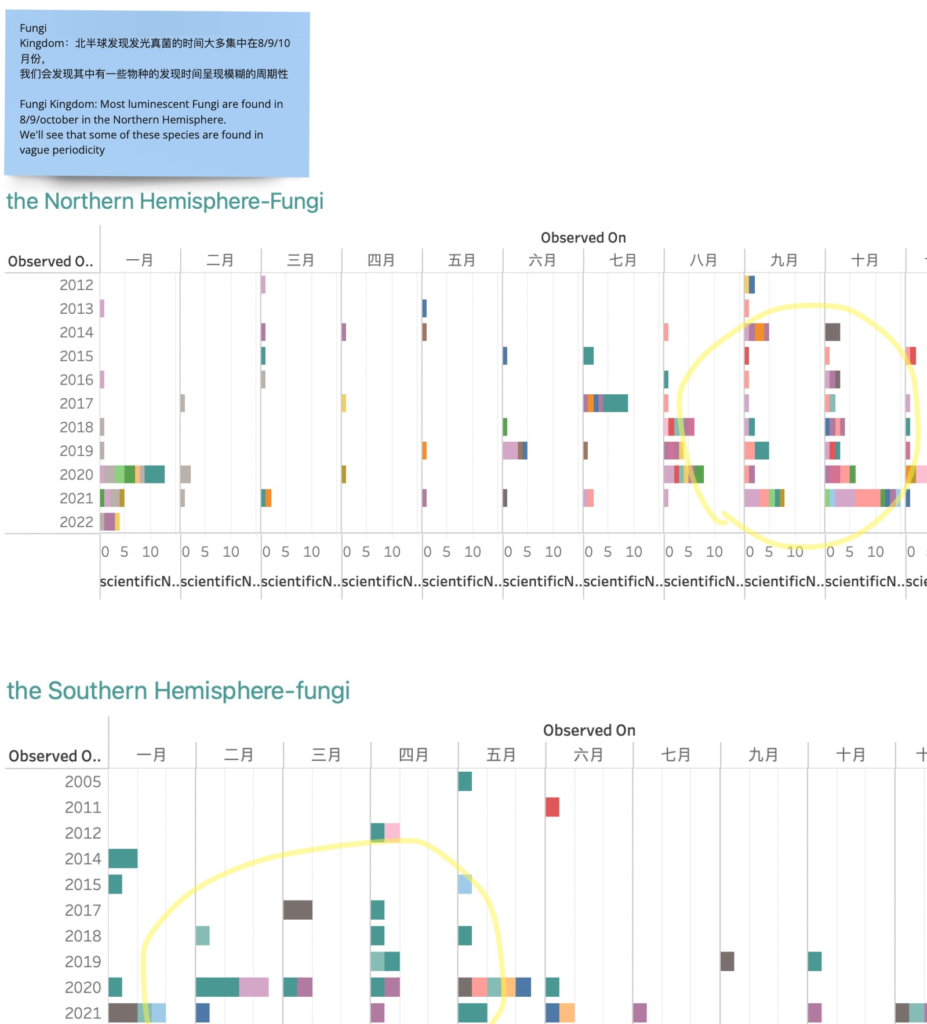
北半球发现发光真菌的时间大多集中在8/9/10月份,我们会发现其中有一些物种的发现时间呈现模糊的周期性。
Fungi Kingdom: Most luminescent Fungi are found in Aug/Sep/October in the Northern Hemisphere.We’ll see that some of these species are found in vague periodicity.

这是几种在观测时间上呈现年复一年的规律的真菌。这让我们对它们的生命周期感到好奇。为什么是这段特定的时间?这让我们联想到这些菌菇的发光属性是否具有同源性?即是否由同种基因表达?
These are several fungi that show year-to-year patterns in observation time. This makes us wonder about their life cycle. Why this particular time? This makes us wonder if the luminescence properties of these fungi are homologous. Is it expressed by the same gene?

从观测数据来看,Mycena 在南北半球都有分布,且观测到它们都是在夏季,这些腐生生物或许非常喜爱潮湿温暖的环境,以提供它们分解有机物的适宜条件。
Mycena was observed in both the northern and southern hemispheres and was observed in the summer. These saprophytes may have enjoyed the moist and warm conditions that provided them with the right conditions to decompose organic matter.
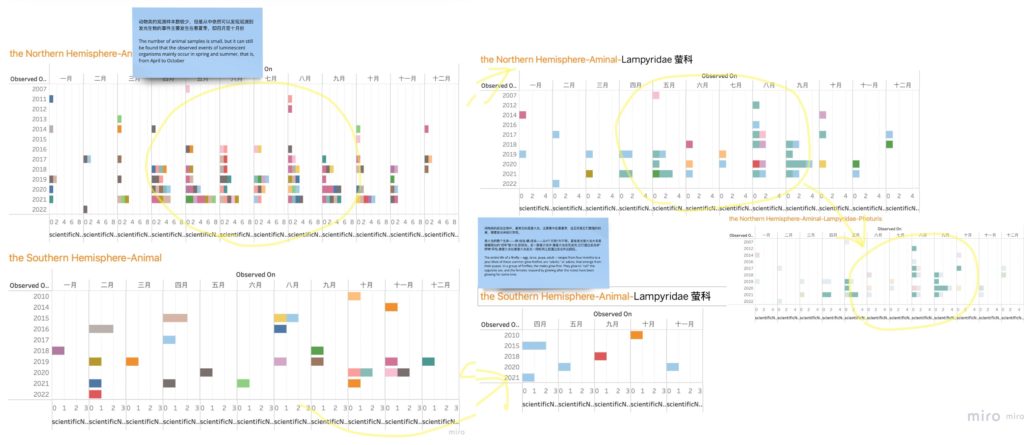
动物类的观测样本数较少,但是从中依然可以发现观测到发光生物的事件主要发生在春夏季,即四月至十月份。动物类的发光生物中,最常见的是萤火虫,主要集中在春夏季,这正好是它们繁殖的时候,需要发光来吸引异性。
萤火虫的整个生命——卵-幼虫-蛹-成虫——从4个月到1年不等。夏夜发光萤火虫大多是破蛹而出的“成年”萤火虫,即成虫。在一群萤火虫中,雄萤火虫会先发光,它们通过发光来“呼唤”异性,雌萤火虫在雄萤火虫发光一段时间之后通过发光作出回应。
The number of animal samples is small, but it can still be found that the observed events of luminescent organisms mainly occur in spring and summer, that is, from April to October.Among the bioluminescent creatures in the animal class, the most common is the firefly, which is mainly concentrated in spring and summer, which is the time when they breed and need to glow to attract the opposite sex.
The entire life of a firefly — egg, larva, pupa, adult — ranges from four months to a year.Most of these summer glow fireflies are “adults,” or adults, that emerge from their pupae. In a group of fireflies, the males glow first. They glow to “call” the opposite sex, and the females respond by glowing after the males have been glowing for some time.
Scientific Support
Bioluminous Mechanism
Almost all bioluminescent organisms known use oxygen to produce the electronically excited product (oxyluciferin), which decays to the ground state by photon emission (see reaction scheme below)[1].
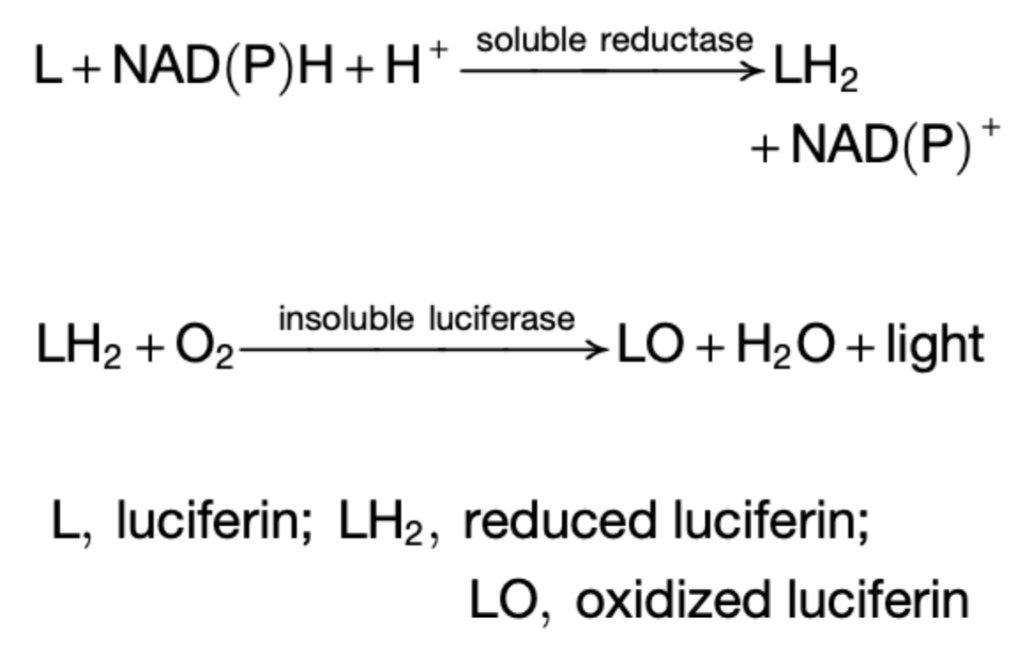

This might can certificate our speculation in 3.1-visualization part that concentration of Oxygen in the environment are related to luminescence. Also, other clues shows the bioluminescence emission is influenced by the ambient humidity. Below are the citiatons.
Anecdotally, it is well known by the local inhabitants and has been observed by authors of this manuscript (C.V.S., H.E.W., and A.G.O.) that the amount of bioluminescence emitted by N. gardneri varies greatly depending, of course, on the size and age of the fruiting body but also on the ambient humidity, optimal conditions being nighttime after a hot day with an afternoon rain storm and a light evening/night breeze. These were the conditions in the forest during the rainy season in March 2013 when the experiments described in the article were performed[2].
已经观察到N. gardneri发出的生物发光量变化很大,当然,这取决于它们的大小和年龄。子实体,但也取决于环境湿度,最佳条件是在炎热的一天后的夜间,下午有暴雨和微风/晚风。
Luminous fungi are found growing on decaying wood, leading to the popular name of “foxfire” or “glow wood” when their glow is visible at night.[55]The responsible oxidative enzymes—known generically as luciferases—produce light by oxidizing a pigment called a luciferin. In some areas, P. stypticus is bioluminescent, and the fruit bodies of these strains will glow in the dark when fresh or sometimes when revived in water after drying.[25] [3]
在腐烂的木材上生长着发光真菌,当它们在夜间发光时,会被称为“狐狸火”或“发光木头”。[55]负责的氧化酶——通常称为luciferases——通过氧化一种叫做aluciferin的色素来产生光。在一些地区,P. stypticus是生物发光的,这些菌株的果体在新鲜时会在黑暗中发光,有时干燥后在水中复活时会发光。[25]
Spectrum
There is still a lack of data about luminous color in the dataset, but this is indeed an important feature for those organisms and also an attractive appearance for people. We consulted some literature and conducted some research and understanding of it.
Many different organisms, ranging from bacteria and fungi to fireflies and fish, are endowed with the ability to emit light, but the bioluminescent systems are not evolutionarily conserved: genes coding for the luciferase proteins (Lase) are not homologous, and the luciferins are also different, falling into many unrelated chemical classes[4].
Generally, knowledge about spectrum can be informed by researches on different organisms according to the categories of Luciferases and other facters which mainly decide the colors. Below[4] is a table identifying Chemistry and color of bioluminescence in different organisms.

To better visualize the different appearce of the Luciferins, here is a spectrum[5] drawn by researchers, which is called as Key properties of natural luciferas- es. Average size and spectral characteristics of natural luciferas- es from different organisms and NanoLuc(天然荧光素的主要特性。不同生物和纳米荧光素的平均大小和光谱特征).

Researcher has also discovered that the color of bioluminescence appears to be associated with habitat, which can be shown both in the graph and the text below.
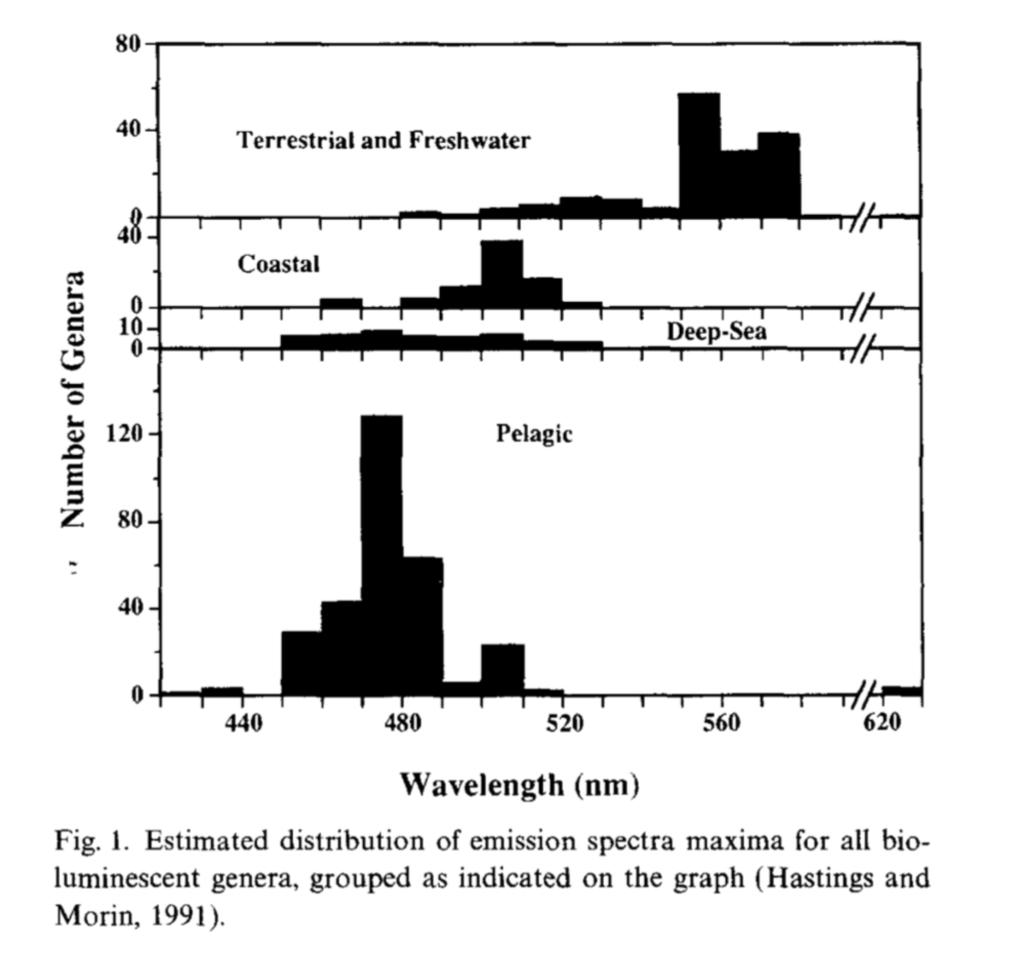
(b) Colors of emission: ecological aspects
Altogether, emission spectra for members of approx. 170 of the approx. 670 luminous genera have been reported; peak emissions are clustered in the blue, the green and the orange, with a few outliers in the deep violet at 400nm and far red at 620nm (Fig. 1). Color appears to be associated to some extent with habitat; the great majority of pelagic and deep sea species have blue emissions, with maxima centered mostly in the 450-490 nm range, while those of the coastal marine species are largely in the green (490-520 nm) region. In contrast, peak emissions of terrestrial and fresh water species are clustered around 550-580 nm..
(b)排放的颜色:生态方面
总的来说,约的成员的发射光谱。大约有170个。共报道发光属670种;峰值辐射聚集在蓝色、绿色和橙色中,在400nm处的深紫色和620nm处的远红色中有一些异常值(图1)。颜色似乎在一定程度上与栖息地有关;绝大多数远洋和深海物种都有蓝色的辐射,最大辐射集中在450-490纳米范围内,而沿海海洋物种的辐射主要在绿色(490-520纳米)区域。相比之下,陆地和淡水物种的峰值辐射聚集在550-580 nm左右[4]。
To conclude, every bioluminescence has its own relatively stable spectrum showing the pattern of light emission. For example, organisms tend to have short wavelengths of light emission in the deep sea, and longer wavelengths of that in the jungle, so the color is closely related to the species and terrain, which is a direction worth exploring. And we also found the color emission can be a cycle which is related to the internal clock of the bioluminescence. These amazing discoveries are closely related to the genes in the bioluminescent organisms.
Flash Patterns
Except for the colors, features can vary from species to species in terms of flash patterns. Below is an example from citation.
Among Japanese local populations of L. cruciata, distinctive geographical variations have been identified in the flash patterns of flying adult males (Kanda, 1935; Ohba, 1984, 2001, 2004b; Tamura et al., 2005). The flash intervals are generally about 4 seconds (slow-flash type) in populations of the northern Japan (to the north of the Fossa Magna region of Honshu), and about 2 seconds (fast-flash type) in the southern Japan (to the south of the Fossa Magna region of Honshu, and Shikoku and Kyushu). Analysis of their mitochondrial cytochrome oxidase II gene revealed three major haplotype groups, namely northern Honshu group, southern Honshu and Shikoku group, and Kyushu group. Among these, the former two groups are more closely related, suggesting the possibility that the populations of the slow-flash type may be derived from the populations of the fast-flash type (Suzuki et al., 2002).[6]
在日本本地的十字花科种群中,已在成年雄性飞行的闪光模式中发现了独特的地理差异(Kanda, 1935 ;Ohba, 1984 , 2001 , 2004b ; Tamura et al., 2005)。闪光间隔在日本北部(本州大窝地区以北)的种群中一般约为 4 秒(慢闪光型),在日本南部(至本州大窝地区、四国和九州以南)。对其线粒体细胞色素氧化酶II基因的分析揭示了三个主要的单倍型组,即本州北部组、本州南部和四国组以及九州组。其中,前两组关系更密切,提示慢闪型种群可能来源于快闪型种群(Suzuki et al., 2002)
Chronobiology Related Evidence
We noticed from the visualization of dataset that the bioluminescence observation events of certain organisms tend to happen during certain months, which made us curious about whether it would show a pattern also in daily scale. Since we don’t have more precise data for observation time, we have to do some literature research. The ealier research suggested that bioluminescence and circadian biology share historical antecedent which means they tends to emit light at certain time in a day.
The reason is actually easy to understand. Take fungi as an example: Fungal bioluminescence is too dim to be perceived by animals during the day but is readily perceived at night (even from smaller and less bright mushrooms than N. gardneri), so rhythmic control luminescence would be an attractive means to eliminate wasting energy through daytime luminescence. [2]真菌生物发光在白天太暗而无法被动物感知,但在夜间很容易感知(即使是比N. gardneri更小、更不亮的蘑菇),因此有节奏的控制发光将是消除白天发光浪费能量的一种有吸引力的方法。
Circadian clocks are biological oscillators responsible for maintaining the internal rhythms of animals, plants, fungi, and cyanobacteria to the alternation of external stimuli as light and temperature [17]. Interestingly, bioluminescence and circadian biology share historical antecedents. Studies of the luminescence of the dinoflagellate Lingulodinium polyedrum (formerly Gonyaulax polyedra), shown to be regulated by a circadian clock, laid the foundations for many of the precepts and paradigms of chronobiology. These include the concept of temperature compensation and the phase response curve, the protocol used to assess the response of the clock to resetting cues as a function of time of day [4]. Although analysis of fungal bioluminescence appeared in the modern literature contemporaneous with that of dinoflagellates [18], the biochemical basis of this luminescence and its possible functional/ecological significance have not been elucidated until very recently [6, 19]. The possibility of circadian regulation was noted in the early 1960s [12, 13], but it was quickly discounted, and in the subsequent 50 years only data questioning rhythmicity have appeared [14, 15].[2]
生物钟是生物振荡器,负责维持动物、植物、真菌和蓝藻的内部节律,以适应外部刺激(如光和温度)的交替变化 [ 17 ]。有趣的是,生物发光和昼夜节律生物学有着共同的历史渊源。对甲藻 Lingulodinium polyedrum (以前称为Gonyaulax polyedra )发光的研究表明受生物钟调节,为时间生物学的许多规则和范式奠定了基础。其中包括温度补偿和相位响应曲线的概念,该协议用于评估时钟对重置提示的响应作为一天中时间的函数 [ 4]。虽然真菌生物发光的分析出现在与甲藻同时期的现代文献中 [ 18 ],但这种发光的生化基础及其可能的功能/生态意义直到最近才被阐明 [ 6 , 19 ]。早在 1960 年代[ 12 , 13 ]就注意到了昼夜节律调节的可能性,但很快就被忽视了,在随后的 50 年中,仅出现了质疑节律性的数据 [ 14 , 15 ]。
We also notice that different species tend to emit light at diffent time, which is a result of their adaption to the enviornment. This provides a possibility that each time points can be represented by different bioluminescent organisms giving light signals. Below is from the citation.
Larvae of A. flava, placed in constant darkness in the laboratory, bioluminesce during the subjective scotophase, typical of nocturnal animals, whereas A. tasmaniensis shows the opposite tendency, bioluminescing most intensely during the subjective photophase.
Observations of bioluminescence in colonies of A. tasmaniensis located in the transition from a cave mouth to the dark zone show that glowing is inhibited by light exposure but a peak bioluminescence follows immediately after “dusk” at their location. The substantial difference in the circadian regulation of bioluminescence between the two species probably reflects adaptation to the cave (hypogean) habitat in A. tasmaniensis and the forest (epigean) habitat in A. flava.[7]
A. flava的幼虫,在实验室中处于持续的黑暗中,在主观暗相期间生物发光,这是夜间动物的典型特征,而A. tasmaniensis则表现出相反的趋势.
在主观光相期间生物发光最强烈 对位于从洞穴口到黑暗区域过渡的塔斯马尼种菌群的生物发光观察表明,光照会抑制发光,但在其位置的“黄昏”之后立即出现峰值生物发光。两个物种之间生物发光昼夜节律调节的显着差异可能反映了对A. tasmaniensis的洞穴(hypogean)栖息地和A. flava的森林(epigean)栖息地的适应。
Visualization of perspective of users
We collected user descriptions and points of interest for luminescent creatures, and obtained the following data and word cloud

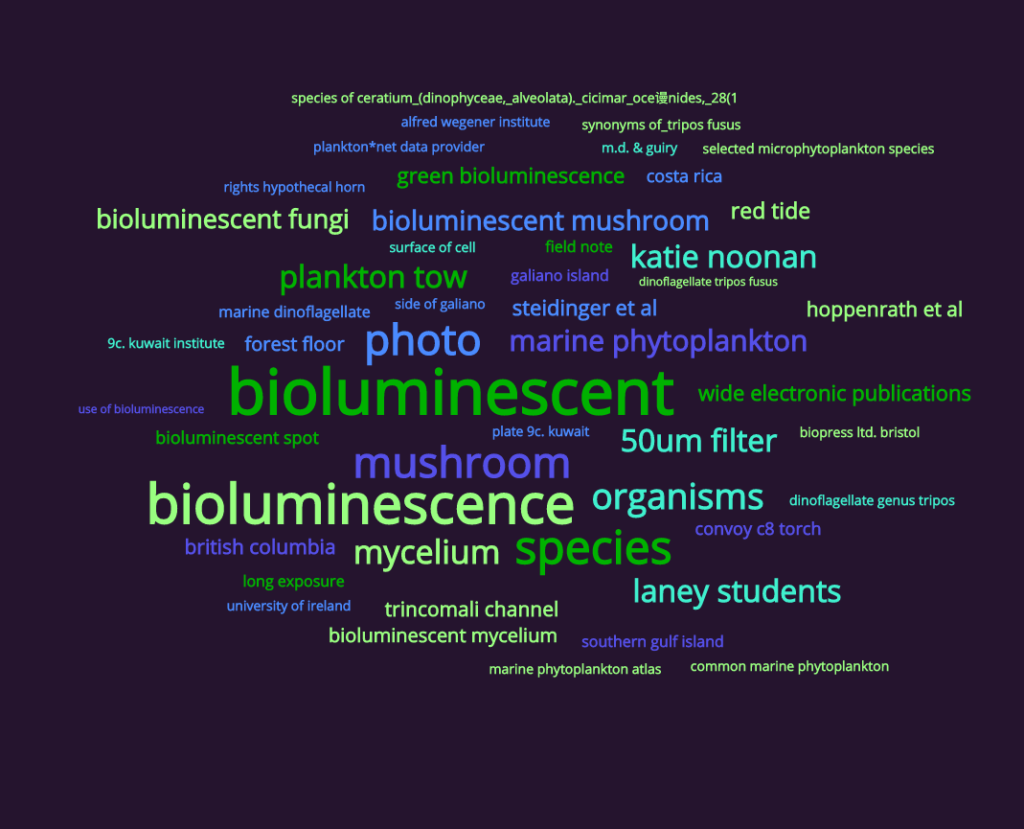
We found that for users, the color, type and shape of luminous creatures are the most attractive parts, and our design can also focus on these places for creation.
Citation:
- Bioluminescence: A Fungal Nightlight with an Internal Timer www.sciencedirect.com/science/article/pii/S0960982215000056
- Circadian Control Sheds Light on Fungal Bioluminescence www.sciencedirect.com/science/article/pii/S0960982215001608
- en.wikipedia.org/wiki/Panellus_stipticus
- Chemistries and colors of bioluminescent reactions: a review* www.tandfonline.com/doi/full/10.3109/07420528.2012.728549?needAccess=true
- Palette of Luciferases: Natural Biotools for New Applications in Biomedicine www.ncbi.nlm.nih.gov/pmc/articles/PMC7385095/
- The Terrestrial Bioluminescent Animals of Japan bioone.org/journals/zoological-science/volume-28/issue-11/zsj.28.771/The-Terrestrial-Bioluminescent-Animals-of-Japan/10.2108/zsj.28.771.full
- Same temporal niche, opposite rhythmicity: two closely related bioluminescent insects with opposite bioluminesce propensity rhythms pubmed.ncbi.nlm.nih.gov/23130886/
Other reference see:
Mechanism and color modulation of fungal bioluminescence www.science.org/doi/full/10.1126/sciadv.1602847
Design Project
Brainstorming
Data:
users uploaded the information they observedto iNaturalist
Information:
The distribution of species types of bioluminescence that have been observed so far
Geographical distribution of bioluminescence that have been observed so far
Date the Bioluminescence was discovered
Knowledge:
物种多样性 地理位置分布差异性 生物活动季节性
Species diversity / geographical distribution / differences biological activity seasonality
Interestingly, bioluminescence and circadian biology share historical antecedents.
insight:
What if spectra could represent the life of different bioluminescent species?
( or Circadian clocks / life cycle)
What if regard bioluminescence as flower, and show its flower season(花期).
Biotiming

